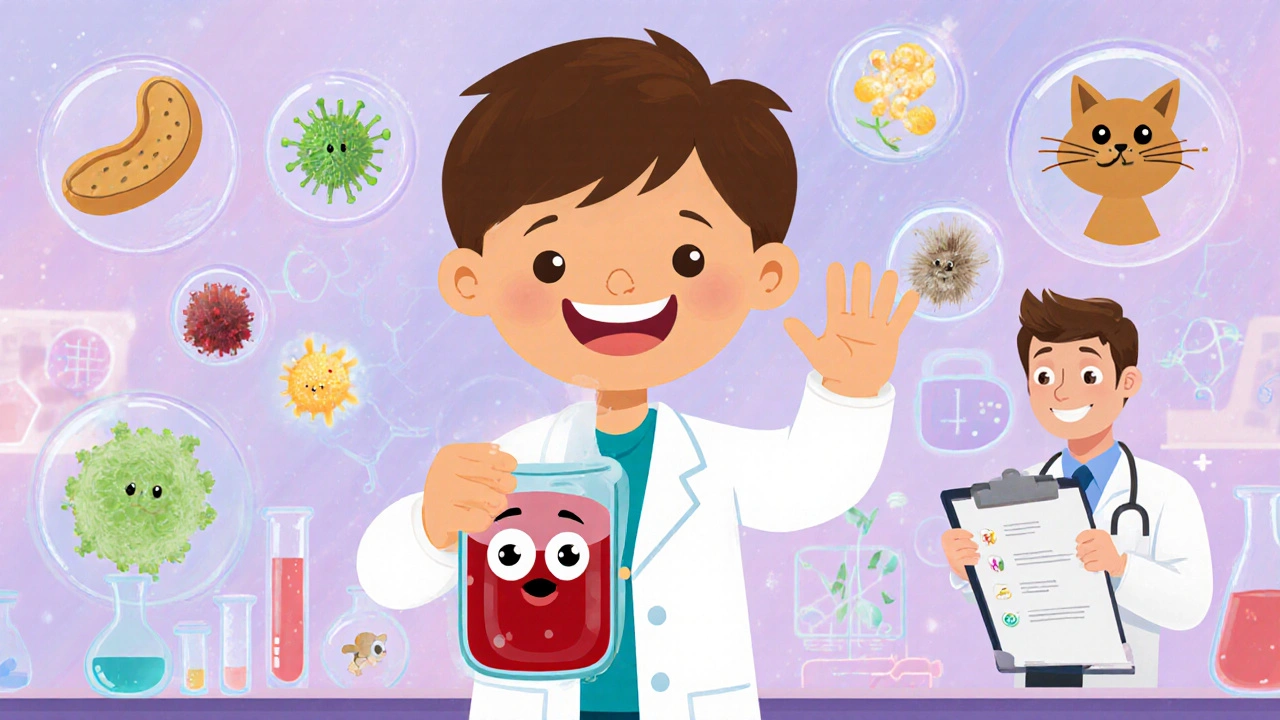
What Specific IgE Testing Actually Measures
Specific IgE testing is a blood test that looks for antibodies your body makes when it reacts to allergens. These antibodies are called immunoglobulin E, or IgE. When you’re allergic to something-like peanuts, pollen, or cat dander-your immune system treats it like an invader and produces IgE antibodies to fight it. The test doesn’t measure how sick you are. It measures how much of that specific antibody is in your blood. That number tells your doctor if you’re sensitized to an allergen.
Back in the 1970s, this test was called RAST, and it only gave a yes-or-no answer. Today’s tests, like ImmunoCAP, give precise numbers in kUA/L units. A result of 0.35 kUA/L or higher usually means you have detectable IgE antibodies. But here’s the catch: having those antibodies doesn’t always mean you’ll have symptoms. That’s why results must be read with your medical history.
Why Doctors Order This Test
Doctors don’t order specific IgE tests just because you think you’re allergic. They use it when there’s a clear pattern. For example: you get hives every time you eat shellfish. Or your nose runs every spring, and you’ve ruled out colds. Or your child broke out in a rash after trying peanut butter for the first time.
The test helps confirm what your symptoms suggest. It’s especially useful when skin testing isn’t possible. If you have severe eczema covering half your body, or if you’re on antihistamines that block skin test results, blood testing becomes the best option. In fact, about 27% of pediatric patients in the U.S. get blood tests instead of skin pricks because they can’t stop their medications.
It’s also used before starting allergy shots (immunotherapy). You need to know exactly what you’re allergic to before your doctor designs a treatment plan. And if you’ve had a near-fatal reaction to food, this test helps identify the trigger so you can avoid it.
How the Test Works and What the Numbers Mean
A small sample of blood-about 2 mL-is drawn and sent to a lab. The most common method used today is Fluorescence Enzyme Immunoassay (FEIA), with ImmunoCAP being the gold standard. Labs like Labcorp and major UK centers use this platform because it’s accurate, consistent, and sensitive down to 0.1 kUA/L.
Results come back as a number: 0.1, 0.5, 3.2, 15.0 kUA/L. These numbers are matched to a scale from 0 to 6:
- 0: less than 0.35 kUA/L - no detectable IgE
- 1: 0.35-0.69 kUA/L - very low
- 2: 0.70-3.49 kUA/L - low
- 3: 3.50-17.49 kUA/L - moderate
- 4: 17.50-49.99 kUA/L - high
- 5: 50.00-99.99 kUA/L - very high
- 6: 100.00+ kUA/L - extremely high
A result of 0.5 kUA/L might sound like a lot, but context matters. If your total IgE is only 1 kUA/L, then 0.5 is half your body’s total allergy antibodies. But if your total IgE is 100 kUA/L, then 0.5 is barely a blip. That’s why labs now automatically check total IgE when a specific IgE comes back positive.
What the Results Don’t Tell You
Many people think a positive IgE test means they’re definitely allergic. That’s not true. Up to 30% of people with positive tests have never had symptoms. This is called sensitization without allergy. You have the antibody, but your body doesn’t react when you’re exposed.
For example, someone might test positive for peanut IgE at 0.8 kUA/L but eats peanut butter every day with no problem. That’s not an allergy. It’s just a lab finding. The real test is what happens when you eat it.
That’s why doctors always ask: What happens when you’re exposed? When did it start? How long after eating did the reaction happen? If you say, “I had a rash 20 minutes after eating eggs,” and your IgE is 5.2 kUA/L, that’s strong evidence. If you say, “I’m not sure,” and your IgE is 0.6 kUA/L, it’s probably not meaningful.
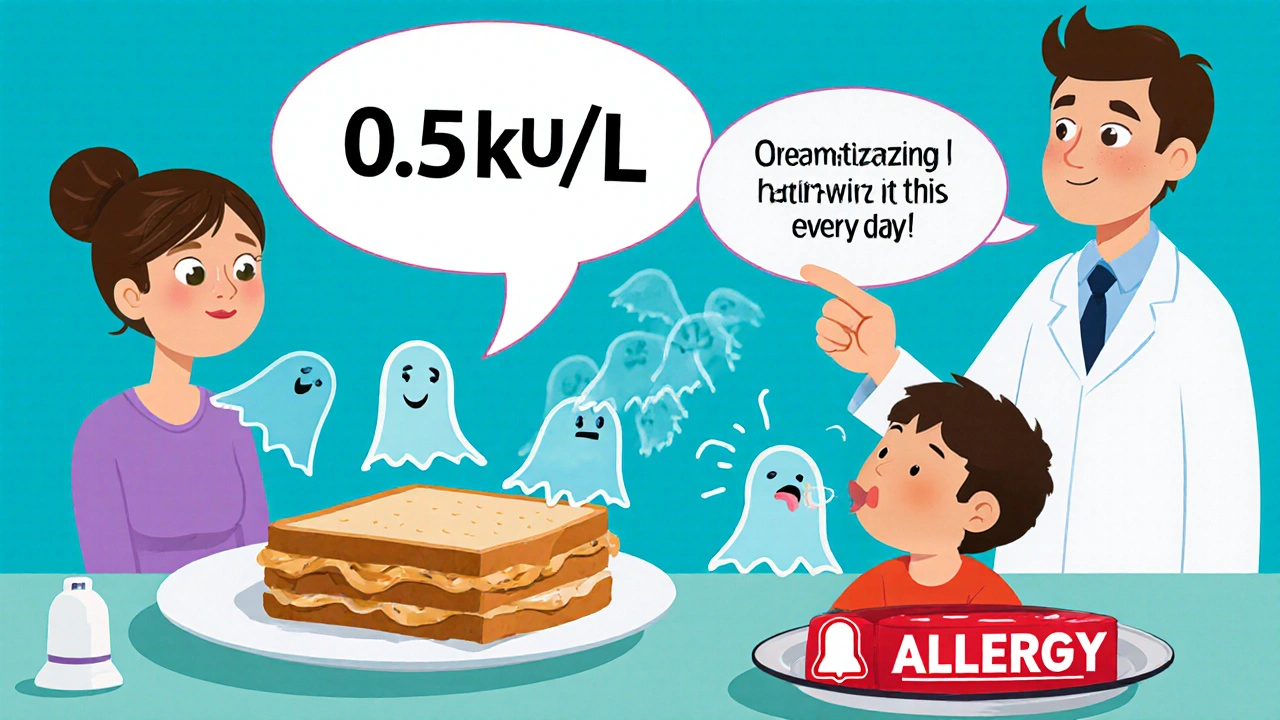
Why You Should Avoid Large Allergy Panels
Some clinics offer “allergy panels” with 20 or more allergens tested at once. Don’t fall for it. The National Guideline for Laboratory Testing (2025) says this is a bad idea. When you test for too many things, you get false positives.
Here’s why: if you test for 20 allergens, and each has a 5% chance of a false positive, you’re statistically likely to get one or two fake results. That’s not science-that’s probability. One study showed that testing for 20+ allergens leads to false positives in nearly 60% of cases.
Also, food mix tests (like “nut panel” or “dairy and wheat combo”) are unreliable. They can’t tell you if you’re allergic to cashew or just cross-reacting with walnut. That’s why guidelines say: test one allergen at a time, based on your history.
If you’ve never eaten cashews but tested positive, it might be because you’re allergic to birch pollen. The proteins in birch pollen look similar to those in cashew. That’s cross-reactivity, not a true allergy. Component-resolved diagnostics (CRD) can help here by testing for specific proteins, not whole foods. But these tests are only available at specialized centers.
How Skin Testing Compares to Blood Testing
Skin prick testing is still the first choice for most allergists. It’s faster, cheaper, and more sensitive. Studies show it detects allergies 15-20% better than blood tests for common triggers like dust mites or grass pollen.
But blood tests have their place. Skin testing can’t be done if you’re on antihistamines, have severe eczema, or are at risk of a dangerous reaction. And it’s harder to do on babies or people with dark skin, where wheals are harder to see.
Here’s a quick comparison:
| Feature | Blood Test (Specific IgE) | Skin Prick Test |
|---|---|---|
| Time to results | 3-5 business days | 15-20 minutes |
| Medication interference | None | Antihistamines block results |
| Best for | Severe eczema, medication users, children | Most adults, no skin disease |
| Sensitivity | 70-85% | 85-95% |
| Measures | Circulating IgE in blood | IgE bound to mast cells in skin |
Neither test predicts how bad a reaction will be. A high IgE level doesn’t mean you’ll go into anaphylaxis. A small skin wheal doesn’t mean you’re safe. Only your history and clinical judgment can do that.
When to Trust the Numbers
Some IgE levels are more meaningful than others. For peanut allergy, a result of 0.35 kUA/L gives you a 50% chance of a real allergy. But at 15 kUA/L? That jumps to 95%. That’s why experts say: don’t just look at the number. Look at the trend.
If your child tested at 0.5 kUA/L for egg at age 2, and now at age 6 it’s 12 kUA/L, that’s a red flag. If it’s dropped to 0.2 kUA/L, they may have outgrown it.
Same with milk. A level under 2 kUA/L in a toddler often means they’ll outgrow it. Over 15 kUA/L? That’s more likely to be lifelong.
For pollen allergies, levels above 3.5 kUA/L are usually linked to symptoms. Below that? It might just be background noise.
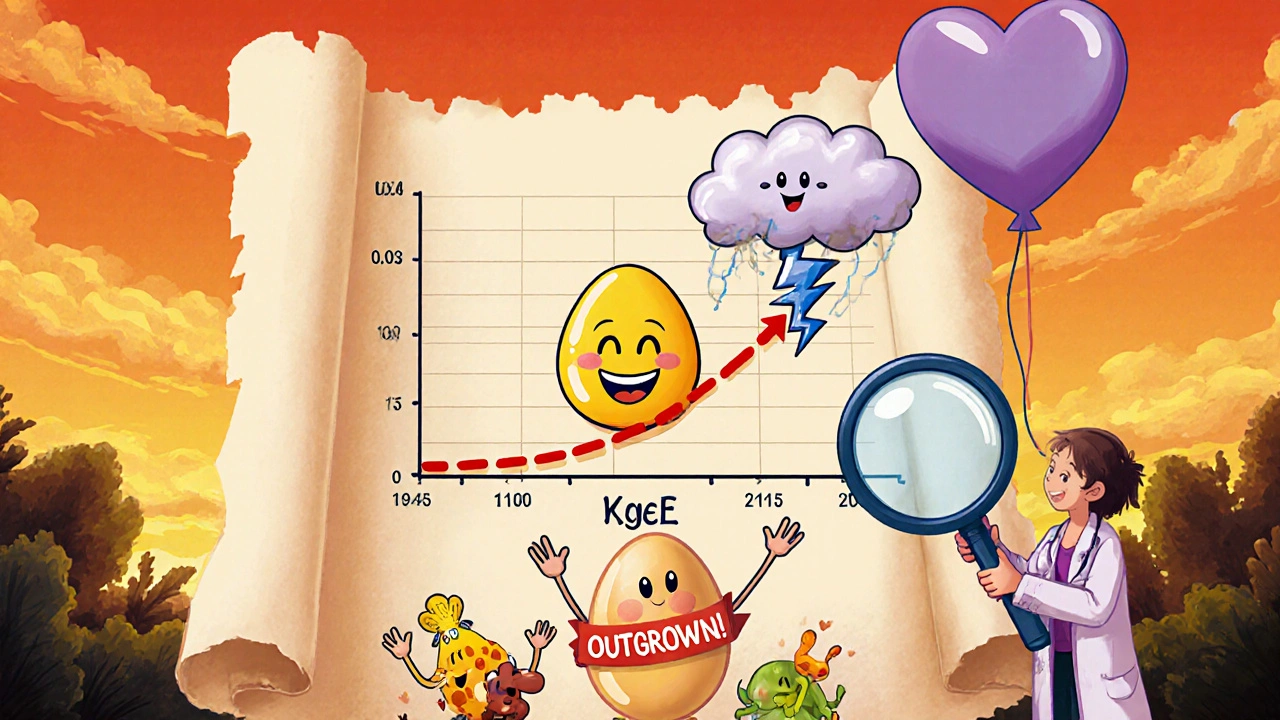
What Happens After the Test
Results take 3-5 days. They’re not urgent. Ninety-eight percent of tests are ordered for long-term planning, not emergency care. Your doctor will review the numbers with your history. If the test matches your symptoms, they’ll make a plan: avoid the trigger, carry an epinephrine pen, or start immunotherapy.
If the test doesn’t match your symptoms? They’ll tell you it’s likely not an allergy. That’s valuable too. You don’t need to avoid foods or environments you’re not actually allergic to.
And if you’re told you’re allergic to 10 things? Ask: Which one is causing my symptoms? Often, it’s just one. Testing everything just creates confusion.
Common Misconceptions
- My IgE is high, so I’m super allergic. Not true. IgE levels don’t predict severity. A person with a 20 kUA/L result might only get a runny nose. Someone with 1 kUA/L might have anaphylaxis.
- I tested positive for shellfish, so I can’t eat any seafood. False. You might be allergic to shrimp but fine with salmon. Allergens are different.
- My child has high IgE, so they’re allergic to everything. No. Kids often have high total IgE for no reason. It’s not a disease.
- I should get tested every year. Unnecessary. Unless your symptoms change, repeat testing adds no value.
Final Thoughts
Specific IgE testing is a powerful tool-but only when used right. It’s not a magic wand. It’s a piece of the puzzle. Your symptoms, your history, and your doctor’s judgment are the rest.
If you’re considering this test, ask: What will I do with the result? If the answer is “I just want to know,” it might not be worth it. If the answer is “I want to avoid a life-threatening reaction,” or “I want to start immunotherapy,” then it’s essential.
Don’t let a lab report tell you what you’re allergic to. Let your life tell you. The test just helps confirm it.

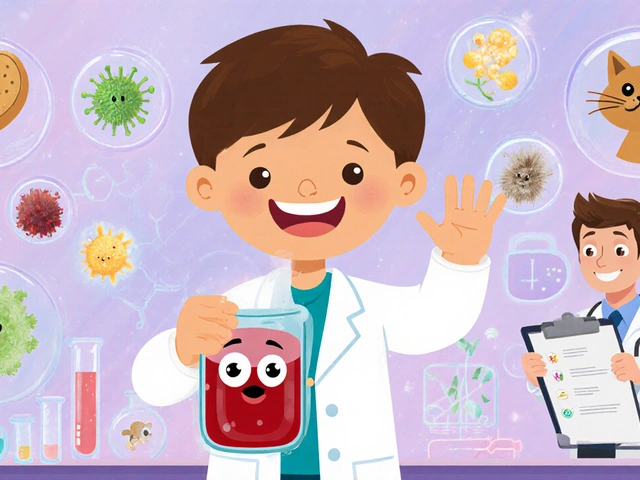




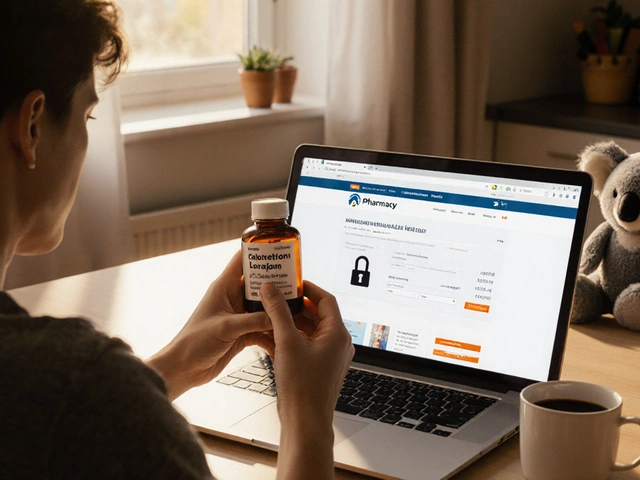
Finally, someone explained this without making it sound like a pharmaceutical ad. I used to stress over my kid's 0.8 kUA/L peanut result until my allergist said, 'He eats it daily with zero reaction - so he’s not allergic.' Mind blown.
Oh great, another post that makes me feel dumb for thinking a positive test = I can't eat it. Like, wow, I didn’t realize my body was just being polite to peanuts. Thanks for the 2000-word lecture on common sense.
In Nigeria we don’t waste money on these fancy blood tests. If you break out after eating groundnut, you stop eating groundnut. No lab needed. These Western labs are just selling fear wrapped in kUA/L. We know our bodies better than machines. Your whole system is overmedicalized. Why not just ask people what they feel? That’s real science.
FEIA and ImmunoCAP are gold standard because they eliminate inter-lab variability - unlike skin tests which depend on technician skill, skin pigmentation, and whether the wheal was measured under fluorescent light or not. The sensitivity gap isn’t just 15-20%, it’s systemic bias in clinical interpretation. We need standardized protocols globally, not just in privileged clinics.
They’re testing for IgE because the FDA and Big Pharma want you to believe you’re allergic to everything. Next thing you know, you’re buying $200 ‘allergy-safe’ snacks. They don’t care if you’re actually allergic - they care if you’re scared enough to buy their products. This whole system is a profit engine disguised as medicine.
The IgE test is a Rorschach blot for modern medicine - we project meaning onto numbers because we fear the ambiguity of lived experience. We’d rather have a 0.6 kUA/L label than sit with the uncomfortable truth: sometimes, your body just reacts unpredictably, and no algorithm can map that. The test doesn’t reveal allergy - it reveals our desperation for certainty.
why do they even test for 20 things at once? its like asking if you’re allergic to air, water, and gravity. i got tested once and they said i was allergic to 12 things including sunlight and silence. i mean i guess that explains why i hate my job. but seriously, labs are just printing false positives to make more money. also i think the guy who wrote this is paid by immuncap.
My mom used to say ‘if it doesn’t make you break out or throw up, it’s not an allergy’ - and honestly? She was right. Thanks for validating that. Also, I’m glad someone called out those 20-item panels. My cousin got one and now avoids 8 foods she’s never even tried. 😅
There’s a deeper philosophical question here: if an allergen triggers no physiological response in a person, does it truly exist as an allergen? Or is it merely a statistical artifact of a system designed to quantify the unquantifiable? The IgE test doesn’t diagnose allergy - it diagnoses our cultural obsession with measurement. We’ve replaced lived experience with decimal points, and now we’re terrified of our own bodies because we’ve outsourced intuition to a machine. The real allergy is to uncertainty.
It is important to note that guidelines from the American Academy of Allergy, Asthma & Immunology clearly state that specific IgE testing should be clinically indicated. Unnecessary testing leads to mismanagement, unnecessary dietary restrictions, and increased healthcare costs. Always correlate results with history. This is not optional - it is standard of care.
My sister’s test showed 0.5 for shellfish. She eats shrimp every Friday. No reaction. Lab result ≠ reality. Just because the machine beeps doesn’t mean your life has to change.
Anyone who trusts a 0.35 kUA/L result as diagnostic is either naive or complicit in medical overreach. I’ve seen patients banned from restaurants based on this garbage. The real danger isn’t peanuts - it’s doctors who treat numbers like oracle readings.
Back home in India, we use ginger and turmeric for everything. If your nose runs in spring, drink warm water with honey. No blood test needed. But I get it - Western medicine needs numbers to feel legitimate. Still, the real cure is listening to your body, not your lab report.